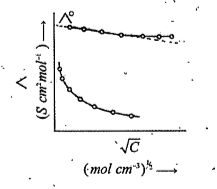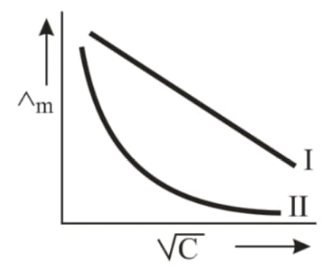The following is a plot of molar conductivity of electrolytesA and B against square root of concentration.
What does (Λ∘m)represent?Give on method for determining (Λ∘m)of the electrolyte B.
 Solution in Malayalam
Solution in Malayalam
Step by step video & image solution for The following is a plot of molar conductivity of electrolytesA and B against square root of concentration.What does (Lambda_m^@)represent?Give on method for determining (Lamda_m^@)of the electrolyte B. by Chemistry experts to help you in doubts & scoring excellent marks in Class 12 exams.
Topper's Solved these Questions
- BOOK - A N EXCEL PUBLICATIONCHAPTER - D AND F - BLOCK ELEMENTSEXERCISE - QUESTION BANK66videos
D AND F - BLOCK ELEMENTS
- BOOK - A N EXCEL PUBLICATIONCHAPTER - GENERAL PRINCIPLES AND PROCESSES OF ISOLATION OF ELEMENTSEXERCISE - QUESTION BANK49videos
GENERAL PRINCIPLES AND PROCESSES OF ISOLATION OF ELEMENTS
Similar Questions
Silver atom has completely-filled d-orbital (4d105s1) in its ground state. How can you say- it is a transition element?
02:09View SolutionWhich of the following equations can't be obtained by the dimensional method? (k is a constant)
View SolutionThe following curve is obtained when molar conductivity (wedge_(m)) is plotted against the square root of concentration, c^(1//2) for two electrolytes A and B (a) How do you account for the increase in the molar conductivity of the electrolyte A on dilution. (b) As seen from the graph, the value of limiting molar conductivity (wedge_(m)^(0)) for electrolyte B cannot be obtained graphically. How can this value be obtained?1
View SolutionHow is the molar conductivity of strong electrolytes at zero concentration determined by graphical method? Why is this method not useful for weak electrolytes?
04:28View SolutionThe variation in Λm with concentration for a strong electrolyte can be represented by the equation, Λm=Λ∘m−AC1/2 The value of constant A for a given solvent and temperature depends upon the type of electrolyte i.e., cations and anions produced on dissociation of electrolyte in the solution .
Which of the following statements is correct regarding variations of molar conductivity with concentration.06:50View SolutionIn the plot of molar conductivity (^ m) vs square root of concentration (c^(1//2)) following curves are obtained for two electrolytes A and B : Answer the following: (i) Predict the nature of electrolytes A and B. (ii) What happens on extrapolation of ^ m to concentration approaching zero for electrolytes A and B?
04:31View Solution
Above plot represents the variation of molar conductance against √C (where C = molar concentration of the electrolyte) . Select the correct option among following .02:49View SolutionThe following curve is obtained when molar conductivity (wedge_(m)) is plotted against the square root of concentration, c^(1//2) for two electrolytes A and B (a) How do you account for the increase in the molar conductivity of the electrolyte A on dilution. (b) As seen from the graph, the value of limiting molar conductivity (wedge_(m)^(0)) for electrolyte B cannot be obtained graphically. How can this value be obtained?1
04:54View SolutionThe variation in Lambda_m with concentration for a strong electrolyte can be represented by the equation, Lambda_m=Lambda_m^@ -AC^(1//2) The value of constant A for a given solvent and temperature depends upon the type of electrolyte i.e., cations and anions produced on dissociation of electrolyte in the solution . Which of the following statements is correct regarding variations of molar conductivity with concentration.
07:44View SolutionHow is the molar conductivity of strong electrolytes at zero concentration determined by graphical method? Why is this method not useful for weak electrolytes?
06:48View SolutionWith decreases in concentration of an electrolytic solution , Conductivity (K) decreases and molar conductivity(∧m)increases.
Limiting molar conductivity(∧∘m)of a strong electrolyte can be determined by graphical extrapolation method, Suggest a method for the determination of limiting molar conductivity of a weak electrolyte, taking acetic acid (CH3COOH) as example .03:27View SolutionConductance(G)conductivity(K)and molar conductivityΛmare terms used in electrolytic conduction.
How do conductivity and molar conductivity vary with concentration of electrolytic solution?05:11View SolutionIt is not possible to determine the molar conductivity of weak electrolyte at infinite dilution(Λ∘m) graphically by extrapolation.
Justify the statement giving reason.01:22View SolutionIt is not possible to determine the molar conductivity of weak electrolyte at infinite dilution(Λ∘m) graphically by extrapolation.
How can this problem be solved? Discuss the principle involved in the method.01:16View SolutionThe following is a plot of molar conductivity of electrolytesA and B against square root of concentration. Write the mathematical relation between Lambda_m and Lambda_m^@ for strong electrolyte(A)
06:32View Solution

